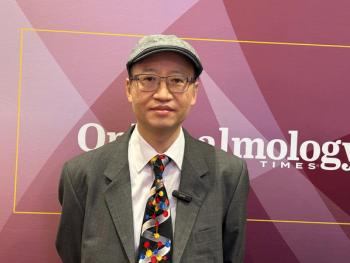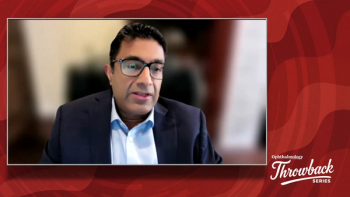
Refractive year characterized by expanding array of treatment choices
By Lynda Charters; Reviewed by Arun C. Gulani, MD, MS, and Peter Hersh, MD
For refractive specialists, “the year 2017 becomes a landmark one when considering that so many technologies are now available to treat patients who previously had been left untreated,” said Arun C. Gulani, MD, MS.
For example, crosslinking (CXL) facilitates stabilization of the cornea before or after refractive surgery. New-generation multifocal toric lens implant options-and even refractive algorithm-based laser systems-are available that provide more precise applications, even in patients with irregular corneas, said Dr. Gulani, who is in private practice, Jacksonville, FL.
“These technologies can turn patients who are not candidates for refractive procedures into those who are candidates for vision corrective surgery,” he said.
CXL, customized CXL
The year 2017 was the start-up year for CXL for treating keratoconus and ectasia, in that many more patients were being treated, especially those with keratoconus, said Peter Hersh, MD, clinical professor, and director, Cornea and Refractive Surgery, Institute of Ophthalmology and Visual Science, both at Rutgers-New Jersey Medical School, Newark, NJ, and in private practice at the Cornea and Laser Eye Institute in Teaneck, NJ.
In the United States, the standard CXL procedure with epithelial removal and 30 minutes of ultraviolet light remains among the most effective of the CXL techniques.
U.S. clinical trials also have been conducted of accelerated CXL and CXL with pulsing, a technique that in theory allows more oxygen to be introduced into the cornea. Completion and results of these studies are awaited.
In the CXL arena, the standard epithelial-off protocol received previous FDA approval. The epithelial-on protocols are currently under evaluation. Historically and internationally, they have achieved mixed results.
In the United States, research studies of epithelial-on protocols are ongoing, and upcoming studies of these protocols in the United States will evaluate different approaches regarding pulsing and oxygen techniques that might lead to more robust clinical results, Dr. Hersh noted.
Customized CXL is another approach under study and is typically performed using the Avedro KXL II unit because two factors need to come into play in the customized procedures (i.e., eye tracking and creation of different treatment shapes). Customized CXL means the pattern of energy distribution in the cornea can be changed to obtain different CXL effects across the entire geometry of the cornea, making placement of the proper energy and the proper shape of the treatment essential, Dr. Hersh explained.
Photorefractive intrastromal CXL (PiXL) for refractive procedures, also one of the newer potential uses of CXL, is used to treat mild myopia, hyperopia, and astigmatism. To treat myopia with PiXL, a small optical zone size is used with large energy delivery; for treating astigmatism, a bow-tie shape; and for hyperopia, an angular shape. These studies are currently ongoing internationally.
Managing keratoconus
The advent of and evolving interest in corneal topography has resulted in earlier and much easier diagnosis of keratoconus.
“We are now seeing patients with keratoconus who are diagnosed when seeking LASIK,” Dr. Hersh said. “Both this increased diagnosis as well as concerns about corneal ectasia had the effect of super-charging research in the field and led to the development of corneal CXL. For patients with keratoconus this is the most important breakthrough since the advent of corneal transplantation.”
CXL is designed to decrease keratoconus progression, however, not to improve topography and vision. Along with CXL, adjunctive placement of intrastromal corneal ring segments (Intacs, Addition Technology) or topography-guided PRK may be useful in selected patients.
“Our current study of Intacs and CXL shows an average flattening of over 7 D with a substantial improvement in corneal symmetry and early treatments with TG-PRK are encouraging,” he said.
He also pointed to innovations in contact lens technology for addressing keratoconus, especially customized lenses and scleral lenses, and to increases in the technologies involved in corneal transplantation. The development of femtosecond laser-assisted penetrating keratoplasty as well as deep anterior lamellar keratoplasty (DALK) is beneficial for keratoconus. Interest is also being shown in transplants of Bowman’s layer to strengthen the cornea.
Dr. Hersh and colleagues have developed a procedure of corneal tissue addition for keratoconus (CTAK), in which preserved corneal tissue is placed within the stroma to improve corneal thickness and shape, which might ultimately facilitate CXL and/or PRK in patients who would have been candidates for only a keratoplasty procedure. They are undertaking a single-center study of CTAK, and early treatments have shown encouraging results.
“We are seeing a tremendous evolution of corneal surgical techniques for keratoconus,” Dr. Hersh said. “Very excitingÂÂ-for the future may be the development of bioengineered corneas. For instance, a few groups of investigators are involved with making artificial corneas from various collagen preparations, such as recombinant human collagens.”
Combination of technologies
Dr. Gulani uses a full spectrum of what he refers to as kerato-lenticulo-refractive techniques and technologies. He implements numerous combination or staged examples, such as Intacs and phakic implants (Visian ICL, STAAR Surgical) together in patients with keratoconus to achieve 20/20 vision, and laser corneal scar correction using Corneoplastique techniques to be followed by premium lens implant cataract surgery resulting in 20/20 outcomes that could not have been reached with the use of these products independently.
With a referral base of previously operated patients seeking correction, he has corrected a range of complications: SMILE (Carl Zeiss Meditec) using laser Corneoplastique, previous corrective vision laser procedures with laser PRK, and patients who had undergone a previous RK procedure with laser Corneoplastique and toric lens implant combinations. He also has modified Descemet membrane endothelial keratoplasty or Descemet stripping automated endothelial keratoplasty procedures to a refractively predictable outcome combined with toric lens implants to achieve emmetropia.
“Surgeons can treat patients that were previously not refractive candidates and bring these patients to the desired refractive endpoint, achieving good vision without the need for spectacle or contact lens correction,” Dr. Gulani said.
New technologies are serving patients in ways that did not exist just a few years previously.
When considering the femtosecond laser in cataract surgery, for example, use of the technology in normal cases can be debated but it does offer a benefit for complicated cases with subluxated cataracts or white mature cataracts.
Newer devices, such as the miLOOP (Iantech) and the Zepto (Mynosys), are providing evolution toward a more robotic cataract surgery with greater abilities to predict and plan the outcomes not only preoperatively, but also intraoperatively with systems such as the ORA System (Alcon Laboratories) and the Callisto eye (Carl Zeiss Meditec), according to Dr. Gulani.
Instrumentation, such as the Pentacam along with the Pentacam AXL scan (Oculus) and the potential acuity meter (NJRetina), has taken diagnosis to the next level. They may help to identify patients with early keratoconus or those who were not previously considered to be suitable candidates for a refractive or premium cataract surgery procedure, including those who had undergone a previous refractive surgery, such as RK, LASIK, and PRK.
Patients who were implanted with a premium IOL and are unhappy can now be identified for the causative factor using the OPD III (Marco) and Tracey systems (Tracey Technologies). They can now undergo an additional refractive procedure to achieve an excellent level of visual acuity rather than offering lens exchange as the only option.
Focusing on presbyopia
Patients with presbyopia have a number of treatments from which to choose.
Inlays (Kamra, AcuFocus; Raindrop Near Vision Inlay, ReVision Optics) are the early mainstays of treatment following spectacle correction for this patient population. Both have received FDA approval. The former relies on pinhole optics to extend the depth of focus without decreasing distance visual acuity, whereas the latter is a small clear disc that mechanically makes the cornea hyperprolate, providing an optical surface that improves near vision.
An IOL (Presbia Flexivue Microlens, Presbia) currently is under clinical trial evaluation.
The use of preserved or nonpreserved corneal tissue inlays and onlays may play a role in the future of presbyopia and hyperopia therapy.
Early European studies have reported success with this approach using SMILE lenticules. A myopic SMILE technique removes a hyperopic lenticule, and a number of case reports have shown that the inlay is well tolerated and this is effective in some patients for improving presbyopia and hyperopia, according to Dr. Hersh.
A new company, Allotex, for which Dr. Hersh is a medical monitor, is developing preserved, laser-prepared corneal tissues that can be used for corneal reconstruction and potentially as a hyperopic or presbyopic inlay or onlay.
“The potential advantage of this technology is that these corneal tissues are likely to be more biofriendly,” Dr. Hersh said. “A difficulty that patients have had over the years with corneal inlays made of a variety of polymers is that they can cause a tissue reaction or overlying stromal problems because of perturbation in metabolic transfer.”
This has been largely addressed by the thinner lens designs of current inlays, but biocompatibility problems still remain, he noted.
“Current inlays need to be placed relatively deep into the cornea and their size and thickness are limited,” Dr. Hersh said. “Tissue inlays and onlays ultimately would likely have an advantage because of the biocompatibility of actual corneal tissue.”
A clinical trial of the Allotex corneal tissue is set to begin in 2018 outside of the United States.
Managing dry eye
The area of dry eye treatment has exploded, from Dr. Gulani’s perspective.
The recently acquired TearScience (Johnson & Johnson Vision) and a number of companies in the dry eye arena have made dry eye management their mission.
“If we can apply technology, technique, and pharmaceuticals in a logical fashion, there is more than just hope for patients with dry eye,” he said. “Clinicians are very well equipped today to understand and treat dry eye.”
In addition to measuring osmolarity and tear film analysis, Dr. Gulani uses the Ocular Keratograph (Oculus) to obtain an extensive evaluation of the quality and stability of the tear film along with a patient-friendly Jenvis report (Oculus).
Another addition to the market this year is lifitegrast (Xiidra, Shire), the first new pharmaceutical for dry eye in more than a decade.
Advances in lasers
Dr. Gulani noted an excimer laser (VISX, Johnson & Johnson) is his workhorse that can address not only virgin eyes but also complex cases including those referred to him for correcting complications of refractive surgery.
The new VISX platform launch may coincide with further applications of the femtosecond laser (VisuMax, Carl Zeiss Meditec) in detailing a full application of cornea-based surgery to take the specialty of cornea to an office-based, vision-oriented superspecialty, which is the foundation of Corneoplastique itself.
With regard to optimizing LASIK outcomes, the advent of topography-guided LASIK (Contoura Vision, Alcon Laboratories) is also leading to better predictability and vision after LASIK.
“We have been performing topography-guided LASIK this past year with great success and even better postoperative results than in the past,” Dr. Hersh said. “We also have found this procedure useful to correct a number of LASIK problems, such as decentration.”
Stagnant LASIK market?
Considering the aforementioned abundance of corrective technologies, the question arises regarding the status of LASIK and whether this market seems to be stagnant in the United States.
“The number of patients undergoing LASIK will increase eventually because the number of refractive patients is increasing overall,” Dr. Gulani said. “At the same time the number of refractive choices also has increased, and hence, the number of patients choosing LASIK may appear to have remained stagnant.
“Patients are now candidates for phakic implants, presbyopic corneal inlays, CXL, and refractive lens exchange rather than LASIK across the board,” he added. “So the patients that choose only LASIK are now distributed among the additional choices. This seems to be a more realistic way of evaluating the marketplace.”
It will be interesting to see the effect of topography-guided LASIK, which was approved by the FDA, on the activity in this market.
“This brings something new to the field,” said Dr. Hersh, noting the “superb” results that patients are attaining.
Another potential game changer is approval of the SMILE procedure.
“We are not seeing a lot of interest in this procedure yet in the United States, but with time, I believe we will see it evolving and being embraced more by surgeons,” Dr. Hersh predicted.
Arun C. Gulani, MD, MS
e: [email protected]
Dr. Gulani has no financial interest in any aspect of this report.
Peter Hersh, MD
e: [email protected]
Dr. Hersh holds stock in Avedro.
Newsletter
Don’t miss out—get Ophthalmology Times updates on the latest clinical advancements and expert interviews, straight to your inbox.



















































.png)


